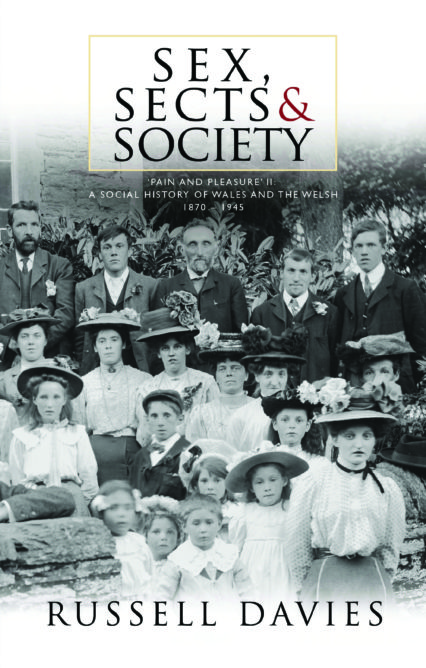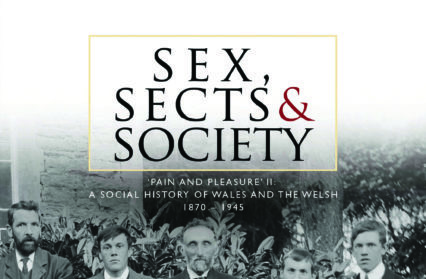Adam Somerset reviews Russel Davies’ Sex, Sects and Society, a book documenting the social history of Wales from 1870 to 1945.
The subtitle of Sex, Sects and Society (University of Wales Press) is Pain and Pleasure: A Social History of Wales and the Welsh 1870-1945. The period, one of colossal change, is presented by Russell Davies with a density of detail and a gusto of style. The author is both immersed in his subject but appears to be enjoying himself. In particular, he brings out the contradictions of the past. The United Kingdom had regular riot and strike but never revolution. Industrial civilisation delivered. Treatment of individual disease was rudimentary but the quality of health in general soared. In 1871 life expectancy for a male in Wales was 39 years and in 1951 it was 70. Morals were tight in public but loose in private. Religious observance soared in the Great Revival and ebbed again by the end of the Second World War.
 The statistics of health in Wales in 2018 make dismal reading. Life expectancy in the Usk Valley varies by ten years from boroughs fifteen miles away. Wales competes with inner Glasgow in health inequality. There is a tradition to this. In 1871, in Builth Wells the death rate was 17 per 1000 inhabitants and in Merthyr 29 per 1000. In the late 1930s almost ten percent of the population was on the TB register. Clement Davies was author of a scathing report on the provision of services. Wales contained seven of the top ten counties for deaths. Some of the remedies – the injection of olive oil, creosote, copper cyanvirate, pig-spleen extract – were themselves lethal. Across rural Wales the rule stood: “coughing in, coffin out.”
The statistics of health in Wales in 2018 make dismal reading. Life expectancy in the Usk Valley varies by ten years from boroughs fifteen miles away. Wales competes with inner Glasgow in health inequality. There is a tradition to this. In 1871, in Builth Wells the death rate was 17 per 1000 inhabitants and in Merthyr 29 per 1000. In the late 1930s almost ten percent of the population was on the TB register. Clement Davies was author of a scathing report on the provision of services. Wales contained seven of the top ten counties for deaths. Some of the remedies – the injection of olive oil, creosote, copper cyanvirate, pig-spleen extract – were themselves lethal. Across rural Wales the rule stood: “coughing in, coffin out.”
Davies’ first chapters, those that deal with the pain rather than pleasure, frequently make grim reading. A “Report on Maternal Mortality in Wales” of 1937 showed that abortion was widespread across all levels of society and the death rate in Wales significantly greater than that in England. The section on suicide covers a range of sorrows with religion, mental illness, wartime trauma all playing their part. Davies writes of Sarah Jacob: “her protracted suicide by starvation is one of the most remarkable and reprehensible stories in Welsh history.” Peg Entwhistle, born in Port Talbot, was a star in 1920s Hollywood, acted with Bogart, and on September 18th1932 jumped from the top of the “H” on the Hollywood sign. Two days later a letter arrived, offering her the lead in a play about a woman who commits suicide.
If Russel Davies records many cases of individual sadness his book is tempered by many episodes of amelioration. The Thomas and Jones families of Anglesey and Liverpool were orthopaedic surgeons of greatness. The innovation of Sir Robert Jones alone reduced the mortality rate from wartime fracture from 80% in 1915 to 20% in 1918. “Jones the Bones” features in Davies’ section on jokes and humour. In Machynlleth an undertaker by the name of Percy Edwards became known as “Perce the hearse”. The pioneer insurance agent in the Rhondda became “Dai Death Club.” The tradition persists. Guidance on all things mechanical in my vicinity is the province of “Perry Petrol.” Less flattering, Davies records, was the professional expertise of the man which earned him the name “Twm cachu.”
In the book’s second half religion and sin battle it out in equal measure. The Victorian state was strong on statistical record. Writers in Wales descended on the registries of births and marriages to prove the moral superiority of the Welsh over the English. They were disappointed. The difference in the rates of illegitimate births divided country from city, rural rates being greater than urban. Conscription in both world wars impelled a mass flight from chastity with its effect on births.
Technological advance was an invaluable servant of sex. The printing presses, in Davies’ words, “produced an enormous amount of pornography”. The portable camera was swift to follow. “Electro-mechanic massagers” were advertised in the most genteel of magazines for women. The copy of advertisements in the Western Mail and Carmarthen Journal offered “thrilling, invigorating, penetrating, revitalising vibrations.” The Well of Loneliness, Davies reports, was based on suffragette Rachel Barrett from Carmarthen and Ida Wylie. Women were exempt from same-sex offences but scandal erupted in Aberystwyth in 1941 and again in 1944. Abergavenny in 1942 was source of the biggest trial: 24 men charged with 192 offences. The grim aftermath was the death of a 19-year old under a Great Western train.
The rich had their relative advantage from prosecution in privacy and travel. The guardians of Tredegar House today are modest in their coverage of Evan Morgan, 2nd Viscount Tredegar. Russel Davies is less restrained. A cockatoo, perched in the trousers flies, was a party favourite. Morgan wore clerical dress for a party where naked attendants served cocaine on silver trays. He lunched in Munich in 1932 with Hess, Roehm and other Nazi leaders. Outside Dinas Powys a Black Magic Mass took place where “young men followed Evan… for flagellation as live tableaux of Christ-at-the-pillar.” In the pious history of Welsh culture Lord Howard de Walden is remembered as the patron of the first national theatre. In this telling parties at his Plas Llanina “often slipped over into orgies.”
If this social history is the stuff of nightmare for Visit Wales and Heritage Wales it is genuinely revealing of a period filled with vivacity, volatility and variability. Gwyn Alf Williams is here alarmed that he has acquired a sexual infection. The location, of all places, is the Urdd Camp in Llangrannog. Rhys Davies “had brief orgiastic sexual encounters with artists, actors, soldiers, especially Welsh Guardsmen.” It is a Wales where denominations proliferate and spiritualism flourishes. Hugh Dalton in 1921 clearly saw the ghost of his friend Rupert Brooke. Chewing tobacco was spat on the floors of church and chapel despite the availability of spitoons. Church and state alike frowned on alcohol. In 1889 the Western Mail conducted a study of shebeens. Its count of illegal drinking sites included 40 in Grangetown, 79 in Cathays, 38 in Canton and 91 in Roath.
Sex, Sects and Society comes under the imprint of the University of Wales. That means an editorial rigour and completeness that is here met in full. The text, both dense and structured, runs to 366 tightly printed pages. The notes run to a further 91 pages. If the presentation is rigorously academic the authorial voice has a puckish touch to it. Russel Davies throws in words like “deisidaimonia” and “peccatogenic”, always careful to add the meaning. “The toponomy of hymnody mirrored the topography” feels like a test with an editor to see if he can get away with it. But it is hard not to warm to a writer who can describe comedian Tommy Cooper from Caerphilly as “an Easter Island statue with the light-footedness of Fred Astaire.”
Sex, Sects and Society is full and rich, a valuable addition to the historiography of Wales. Unusually, prior to this review, I read it twice in full to get a grasp of its breadth and detail. The discovery of the book was accidental. Characteristically, in a subsidy-drenched culture, not a sighting was to be seen of advertising or promotion. The categorical error is endemic across every branch of the cultural magistracy: relief from the market is misinterpreted as release from the market.
Sex, Sects and Society by Russel Davies is available at University of Wales Press.
Adam Somerset is an essayist and a regular contributor to Wales Arts Review.











